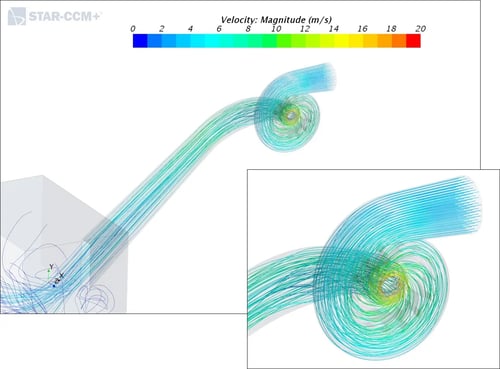Optimization of Hydroturbine with CFD Modeling of Discharge Chamber
Accurate modeling produces accurate results that correlate well with real-world behavior
MSI was tasked by an OEM to create a site-specific design for a hydro turbine. It is typical in the course of the design to assume that the hydro turbine in question would discharge into a large body of water. Therefore the CFD model of the design in question was evaluated in the manner analogous with that assumption, as shown in the following plot, with a generic plenum geometry following the draft tube.

Nearly 9 million cells helps accurately model real-world behavior

CFD modeling provides velocity streamlines for excellent characterization of hydro turbine flow
However, in the course of the project it became evident that the turbine in question would not be discharging into a large plenum, but rather into a relatively small open-air chamber that would then spill over into a river. This chamber would naturally add a certain amount of backpressure which would change the power production of the turbine, and the predictions for the design performance based on the CFD analyses would thus have to be adjusted.

|

|
The small open-air chamber provided atypical backpressure to the hydro turbine
Thankfully, due to MSI’s considerable computational resources, a full 360° model of the turbine design, including the draft tube chamber with a free surface, was able to be analyzed in a transient manner. A transient CFD analysis, where the mesh of a rotating domain is moved with respect to the stationary components at every timestep, is a lot more computationally intensive than a steady-state analysis, but also offers much more precise predictive capabilities. In addition to the usual solvers, this analysis also included a multiphase VOF (volume of fluid) model, to account for the free surface and the presence of air in the draft tube chamber.
Full three-dimensional modeling of the discharge behavior
Using the modified transient CFD analysis which included the chamber geometry, MSI was better able to predict the turbine performance, as evidenced in the following video.
Actual video of the discharge behavior
REAL-WORLD EXAMPLES AND CASE STUDIES
MSI In Action
Case Study
Rerate of a Francis Hydro Turbine
MSI was tasked with optimizing a 1920s Francis style hydro-turbine runner.
Case Study
Reconciling Predicted Results to Test Stand
Test stand data vs. predicted performance.
Case Study
Analysis of Multiple Hydro Turbines in a Parallel Array
Modeling and analysis of parallel hydro turbines.
